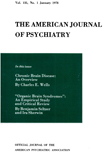Corrections
Abstract
On page 1178 of the September 1979 issue, in "Status of Psychotropic Drug Blood Level Assays and Other Biochemical Measurements in Clinical Practice" by Ross J. Baldessarini, M.D., the last three full sentences of the first column should read, "Although antidepressant levels are often reported as nanograms (10–9 mg) per milliliter, a more rational unit for all drug assays would be picomoles per milliliter to correct for dissimilarities in molecular weight. Thus, levels of tricyclic antidepressants are typically 50-300 ng/ml, or about 200-1000 pmol/ml (table 1). Toxicity may occur in susceptible patients above 500 ng/ml (about 2000 pmol/ml) and is routine above 1000 ng/ml for most agents. "On page 1179, the heading for the last column in table 1 should read "pmol/ml," and footnote b should be, "Levels are commonly reported in nanograms per milliliter, although picomoles per milliliter is preferable." The staff regrets this error.
Access content
To read the fulltext, please use one of the options below to sign in or purchase access.- Personal login
- Institutional Login
- Sign in via OpenAthens
- Register for access
-
Please login/register if you wish to pair your device and check access availability.
Not a subscriber?
PsychiatryOnline subscription options offer access to the DSM-5 library, books, journals, CME, and patient resources. This all-in-one virtual library provides psychiatrists and mental health professionals with key resources for diagnosis, treatment, research, and professional development.
Need more help? PsychiatryOnline Customer Service may be reached by emailing [email protected] or by calling 800-368-5777 (in the U.S.) or 703-907-7322 (outside the U.S.).



